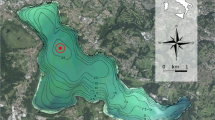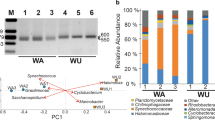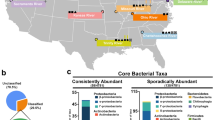Abstract
A wide variety of cyanobacterial species that inhabit freshwater systems are known to produce diverse toxins and off-flavor compounds during the development of environmentally harmful blooms. However, cyanobacterial community development and toxin production potential have not been well studied. In this study, we examined the taxonomic diversity and saxitoxin production potential of cyanobacteria in the water and sediments of a large river, the North Han River in South Korea, by metagenome analysis using next-generation sequencing (NGS) and molecular biological approaches, respectively. NGS revealed that the entire cyanobacterial community in the study area consisted of 39 genera and 47 species. The most abundant genera were Microcystis, Anabaena, Cyanobium, and Synechococcus, which accounted for more than 90% of the entire community. The saxitoxin production potential of the cyanobacterial community was assessed by detecting the sxtA and sxtG genes related to saxitoxin production. Eleven sxtA and 24 sxtG genes were identified through molecular cloning and sequencing. Phylogenic analysis revealed that three sxtA genes that grouped in one phylogenic branch with Scytonema sp. were distinctly separated from the sxtA genes of Anabaena, Aphanizomenon, Lyngbya, and Cylindrospermopsis. Sixteen of the detected sxtG genes were phylogenically similar to those of Anabaena circinalis (Dolichospermum circinale), Aphanizomenon gracile, and Aphanizomenon flos-aquae. Our study demonstrates the utility of the metagenomics approach for characterizing the natural community structure of cyanobacteria containing diverse and even rare species, and the evaluation of saxitoxin-producing potential in the cyanobacterial community.




Similar content being viewed by others
References
Paerl HW, Hall NS, Calandrino ES (2011) Controlling harmful cyanobacterial blooms in a world experiencing anthropogenic and climatic-induced change. Sci Total Environ 409(10):1739–1745
Paerl HW, Fulton RS, Moisander PH, Dyble J (2001) Harmful freshwater algal blooms, with an emphasis on cyanobacteria. Sci World J 1:76–113
WHO (2003) Cyanobacterial toxins: microcystin-LR in drinking-water. Background document for development of WHO Guidelines for drinking-water quality, 2nd edn. World Health Organization, Geneva
EPA (2015) Drinking water health advisory for the cyanobacterial microcystin toxins. United States Environmental Protection Agency, Washington, USA
NSW (2015) Blue-green algae blooms: risks to fishers. D.o.P. industries, Editor
Humpage A, Rositano J, Bretag AH, Brown R, Baker PD (1994) Paralytic shellfish poisons from Australian cyanobacterial blooms. Mar Freshw Res 45(5):761–771
Pearson L, Mihali T, Moffitt M, Kellmann R, Neilan B (2010) On the chemistry, toxicology and genetics of the cyanobacterial toxins, microcystin, nodularin, saxitoxin and cylindrospermopsin. Mar Drugs 8(5):1650–1680
Batoréu M, Dias E, Pereira P, Franca S (2005) Risk of human exposure to paralytic toxins of algal origin. Environ Toxicol Pharmacol 19(3):401–406
Metcalf JS, Codd GA (2014) Cyanobacterial toxina (Cyanotoxin) in water, 2014. Foundation for Water Research, Amsterdam
Dos Anjos FM, Do Carmo Bittencourt-Oliveira M, Zajac MP, Hiller S, Christian B, Erler K, Luckas B, Pinto E (2006) Detection of harmful cyanobacteria and their toxins by both PCR amplification and LC-MS during a bloom event. Toxicon 48(3):239–245
Foss AJ, Phlips EJ, Yilmaz M, Chapman A (2012) Characterization of paralytic shellfish toxins from Lyngbya wollei dominated mats collected from two Florida springs. Harmful Algae 16:98–107
Ballot A, Fastner J, Wiedner C (2010) Paralytic shellfish poisoning toxin-producing cyanobacterium Aphanizomenon gracile in northeast Germany. Appl Environ Microbiol 76(4):1173–1180
Hoff-Risseti C, Dorr FA, Schaker FD, Pinto E, Werner VR, Fiore MF (2013) Cylindrospermopsin and saxitoxin synthetase genes in Cylindrospermopsis raciborskii strains from Brazilian freshwater. PLoS ONE 8(8):e74238
Moustafa A, Loram JE, Hackett JD, Anderson DM, Plumley FG, Bhattacharya D (2009) Origin of saxitoxin biosynthetic genes in cyanobacteria. PLoS ONE 4(6):e5758
Srivastava A, Ko SR, Ahn CY, Oh HM, Ravi AK, Asthana RK (2016) Microcystin biosynthesis and mcyA expression in geographically distinct microcystis strains under different nitrogen, phosphorus, and boron regimes. Biomed Res Int 2016:13
Boopathi T, Ki J-S (2014) Impact of environmental factors on the regulation of cyanotoxin production. Toxins 6(7):1951–1978
Chorus I, Bartram J (1999) Toxic cyanobacteria in water: a guide to their public health consequences, monitoring and management. WHO, London
New-Zealand Ministry of Health (2016) Guidelines for drinking-water quality management for New Zealand. Ministry of Health, Wellington
Whitton BA (2012) Ecology of cyanobacteria II: their diversity in space and time. Springer, Berlin
Park HJ (2013) Study on harmful cyanobacteria and off-flavor production in Lake Paldang. Konkuk University, Seoul
Baek JS (2015) The phytoplankton community and the waterquality assessment in Paldang-Lake. Kyonggi University, Seoul
Kim YJ, Baek JS, Youn SJ, Kim HN, Lee BC, Park S, You KA, Lee JK (2016) Cyanobacteria community and growth potential test in sediment of lake Paldang. Journal of Korean Society on Water Environment 32:9
Lee HS, Oh KH, Cho YC (2008) Isolation of cyanobacteria producing microcystin from lakes. Korean J Microbiol 44(3):6
Kim YG, Shin YK, Choi JK (2000) Studies on the phytoplankton community in the Paldang Lake. Environ Sci Eng Center Sang-ji Univ 6:11
Park H-K, Jheong WH, Kwon OS, Ryu J-K (2000) Seasonal succession of toxic cyanobacteria and microcystins concentration in Paldang reservoir. Algae 15(1):29–35
Jheong WH (2001) Characteristics of occurrence and control of cyanobacteria and phytoplankton in Lake Paldang. Dankook University, Yongin
D’Agostino PM, Song X, Neilan BA, Moffitt MC (2016) Proteogenomics of a saxitoxin producing and non toxic strain of Anabaena circinalis (cyanobacteria) in response to extracellular NaCl and phosphate depletion. Environ Microbiol 18(2):461–476
Lin X, Ding H, Zeng Q (2016) Transcriptomic response during phage infection of a marine cyanobacterium under phosphorus-limited conditions. Environ Microbiol 18(2):450–460
Hii KS, Lim PT, Kon NF, Takata Y, Usup G, Leaw CP (2016) Physiological and transcriptional responses to inorganic nutrition in a tropical Pacific strain of Alexandrium minutum: implications for the saxitoxin genes and toxin production. Harmful Algae 56:9–21
D’Agostino PM, Woodhouse JN, Makower AK, Ac Yeung, Ongley SE, Micallef ML, Moffitt MC, Neilan BA (2016) Advances in genomics, transcriptomics and proteomics of toxin producing cyanobacteria. Environ Microbiol Rep 8(1):3–13
Lazarevic V, Gaïa N, Girard M, François P, Schrenzel J (2013) Comparison of DNA extraction methods in analysis of salivary bacterial communities. PLoS ONE 8(7):e67699
Bolger AM, Lohse M, Usadel B (2014) Trimmomatic: a flexible trimmer for Illumina sequence data. Bioinformatics 30(15):170
Mende DR, Waller AS, Sunagawa S, Järvelin AI, Chan MM, Arumugam M, Raes J, Bork P (2012) Assessment of metagenomic assembly using simulated next generation sequencing data. PLoS ONE 7(2):e31386
Zerbino DR, Birney E (2008) Velvet: algorithms for de novo short read assembly using de Bruijn graphs. Genome Res 18(5):821–829
Namiki T, Hachiya T, Tanaka H, Sakakibara Y (2012) MetaVelvet: an extension of Velvet assembler to de novo metagenome assembly from short sequence reads. Nucleic Acids Res 40(20):e155–e155
Rho M, Tang H, Ye Y (2010) FragGeneScan: predicting genes in short and error-prone reads. Nucleic Acids Res 38(20):e191–e191
Buchfink B, Xie C, Huson DH (2015) Fast and sensitive protein alignment using DIAMOND. Nat Methods 12(1):59–60
Huson DH, Auch AF, Qi J, Schuster SC (2007) MEGAN analysis of metagenomic data. Genome Res 17(3):377–386
Huson DH, Mitra S, Ruscheweyh HJ, Weber N, Schuster SC (2011) Integrative analysis of environmental sequences using MEGAN4. Genome Res 21(9):1552–1560
Komárek J, Komárková J (2004) Taxonomic review of the cyanoprokaryotic genera Planktothrix and Planktothricoides. Czech Phycol 4:1–18
Komárek J, Zapomělová E (2007) Planktic morphospecies of the cyanobacterial genus Anabaena = subg. Dolichospermum–1. Part: coiled types. Fottea 7(1):1–31
Komárek J, Zapomělová E (2007) Planktic morphospecies of the cyanobacterial genus Anabaena = subg. Dolichospermum–2. part: straight types. Fottea 8(1):1–14
Felisberto SA, e Souza DBS (2014) Characteristics and diversity of cyanobacteria in periphyton from lentic tropical ecosystem, Brazil. Adv Microbiol 4(15):1076
HRWEMD (2012) Distribution and eco-physiological characteristics of harmful algae in North Han River. Final Report, H.R.W.a.E.M. District)
HRWEMD (2013) Investigation of causes of off-flavor material production by harmful algae and management strategy. Final Report, H.R.W.a.E.M. District
Kim KH, Lim BJ, You KA, Park MH, Park JH, Kim KH, Hwang SJ (2014) Identification and analysis of geosmin production potential of Anabaena strain isolated from North Han River. Korean J Ecol Environ 47(4):7
Tamura K, Stecher G, Peterson D, Filipski A, Kumar S (2013) MEGA6: molecular evolutionary genetics analysis version 6.0. Mol Biol Evol 30(12):2725–2729
Han MS, Auh YY, Ryu JK, Yoo KI, Choi YK (1995) Ecological studies on Pal'tang River-reservoir system in Korea 2. Changes in phytoplankton community structure. Korean J Limnol 28:335–344
Hong SS, Auh YY (2002) Ecological studies on Pal'tang river—reservoir system in Korea 4. Dynamics on inorganic nutrients, POM and phytoplankton succession in the lower stream Kyungan. Korean J Ecol Environ 35(1):9
Han MS, Jheong WH, Park JD, Kim JM (2005) Correlation between phytoplankton dynamics and water quality in Paldang Reservoir. Korean J Limnolo 38(2):7
Park H, Lee HJ, Kim EK, Jung DI (2005) Characteristics of algal abundance and statistical analysis of environmental factors in Lake Paldang. J Korean Soc Water Qual 21:584–594
HRWEMD (2015) Investigation of causes of off-flavor material production by harmful algae and management strategy. Final Report, H.R.W.a.E.M. District, Editor
Casero MC, Ballot A, Agha R, Quesada A, Cirés S (2014) Characterization of saxitoxin production and release and phylogeny of sxt genes in paralytic shellfish poisoning toxin-producing Aphanizomenon gracile. Harmful algae 37:28–37
Kellmann R, Mihali TK, Jeon YJ, Pickford R, Pomati F, Neilan BA (2008) Biosynthetic intermediate analysis and functional homology reveal a saxitoxin gene cluster in cyanobacteria. Appl Environ Microbiol 74(13):4044–4053
Al-Tebrineh J, Mihali TK, Pomati F, Neilan BA (2010) Detection of saxitoxin-producing cyanobacteria and Anabaena circinalis in environmental water blooms by quantitative PCR. Appl Environ Microbiol 76(23):7836–7842
Beltran EC, Neilan BA (2000) Geographical segregation of the neurotoxin-producing cyanobacterium Anabaena circinalis. Appl Environ Microbiol 66(10):4468–4474
Mahmood NA, Carmichael WW (1986) Paralytic shellfish poisons produced by the freshwater cyanobacterium Aphanizomenon flos-aquae NH-5. Toxicon 24(2):175–186
Cirés S, Wörmer L, Ballot A, Agha R, Wiedner C, Velázquez D, Casero MC, Quesada A (2014) Phylogeography of cylindrospermopsin and paralytic shellfish toxin-producing Nostocales cyanobacteria from Mediterranean Europe (Spain). Appl Environ Microbiol 80(4):1359–1370
Smith FM, Wood SA, van Ginkel R, Broady PA, Gaw S (2011) First report of saxitoxin production by a species of the freshwater benthic cyanobacterium, Scytonema Agardh. Toxicon 57(4):566–573
Ongley SE, Pengelly JJ, Neilan BA (2016) Elevated Na+ and pH influence the production and transport of saxitoxin in the cyanobacteria Anabaena circinalis AWQC131C and Cylindrospermopsis raciborskii T3. Environ Microbiol 18(2):427–438
Wang D-Z, Zhang SF, Zhang Y, Lin L (2016) Paralytic shellfish toxin biosynthesis in cyanobacteria and dinoflagellates: a molecular overview. J Proteom 135:132–140
McGregor GB (2013) Freshwater cyanobacteria of north-eastern Australia: 2. Chroococcaes (Phytotaxa 133). Magnolia Press, Auckland, p 130
Acknowledgments
This study was financially supported by the Basic Environmental Research Program of the Han River System (2013–2015) of the Han River Watershed Environmental Office (the Ministry of Environment, Republic of Korea). The authors are grateful to the members of Limnology Laboratory in Konkuk University for their field assistance.
Author information
Authors and Affiliations
Corresponding author
Rights and permissions
About this article
Cite this article
Kim, K.H., Yoon, Y., Hong, WY. et al. Application of metagenome analysis to characterize the molecular diversity and saxitoxin-producing potentials of a cyanobacterial community: a case study in the North Han River, Korea. Appl Biol Chem 61, 153–161 (2018). https://doi.org/10.1007/s13765-017-0342-4
Received:
Accepted:
Published:
Issue Date:
DOI: https://doi.org/10.1007/s13765-017-0342-4




